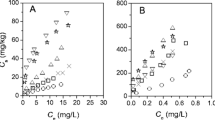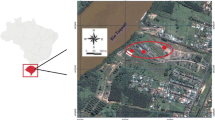Abstract
Purpose
The choice and timing of microorganisms added to soils for bioremediation is affected by the dominant bioavailable contaminants in the soil. However, changes to the concentration of bioavailable PAHs in soil are not clear, especially when several PAHs coexist. This study investigated the effects of PAH concentration and chemical properties on desorption in meadow brown soil after a 1-year aging period, which could reflect changes of PAH bioavailability during bioremediation.
Materials and methods
Based on the percentage of different molecular weights in a field investigation, high-level contaminated soil (HCS) and low-level contaminated soil (LCS) were prepared by adding phenanthrene (PHE), pyrene (PYR) and benzo(a)pyrene (BaP) to uncontaminated meadow brown soil. The concentrations of HCS and LCS were 250 mg kg−1 (PHE, PYR, and BaP: 100, 100, and 50 mg kg−1) and 50 mg kg−1 (PHE, PYR, and BaP: 20, 20, and 10 mg kg−1) respectively. The soils were aged for 1 year, after which desorption was induced by means of a XAD-2 adsorption technique over a 96-h period.
Results and discussion
The range of the rapidly desorbing fraction (F rap) for PHE, PYR, and BaP in HCS and LCS was from 1.9 to 27.8 %. In HCS, desorption of PYR was most difficult, and the rate constant of very slow desorption (K vs) of PYR was 8 orders of magnitude lower than that of BaP, which had similar very slow desorbing fractions (49.8 and 50.5 %, respectively). However, in LCS, desorption of PYR was the easiest; the Kvs of PYR was 8–10 orders of magnitude higher than those of PHE and BaP. In HCS, the time scale for release of 50 % of the PAHs was ranked as BaP > PYR > PHE, while in LCS this was BaP > PHE > PYR.
Conclusions
The combined effect of PAH concentrations and properties should be taken into account during desorption. The desorption of PAH did not always decrease with increasing molecular weight, and the desorption of four-ring PAHs might be special. These results are useful for screening biodegrading microbes and determining when they should be added to soils based on the dominant contaminants present during different periods, thus improving the efficiency of soil bioremediation.

Similar content being viewed by others

References
Braida WJ, White JC, Zhao D, Ferrandino FJ, Pignatello JJ (2002) Concentration-dependent kinetics of pollutant desorption from soils. Environ Toxicol Chem 21:2573–2580
Brion D, Pelletier É (2005) Modelling PAHs adsorption and sequestration in freshwater and marine sediments. Chemosphere 61:867–876
Cebron A, Cortet J, Criquet S, Biaz A, Calvert V, Caupert C, Pernin C, Leyval C (2011) Biological functioning of PAH-polluted and thermal desorption-treated soils assessed by fauna and microbial bioindicators. Res Microbiol 162:896–907
Chai Y, Kochetkov A, Reible DD (2006) Desorption resistance of polycyclic aromatic hydrocarbons and duration of exposure. Environ Toxicol Chem 25:2827–2833
Colombo M, Cavalca L, Bernasconi S, Andreoni V (2011) Bioremediation of polyaromatic hydrocarbon contaminated soils by native microflora and bioaugmentation with Sphingobium chlorophenolicum strain C3R—a feasibility study in solid-and slurry-phase microcosms. Inter Biodeter Biodegr 65:191–197
Cornelissen G, Noort PC, Parsons JR, Govers HA (1997) Temperature dependence of slow adsorption and desorption kinetics of organic compounds in sediment. Environ Sci Technol 31:454–460
Cornelissen G, Pv N, Govers H (1998a) Mechanisms of slow desorption of organic compounds from sediments: a study using model sorbents. Environ Sci Technol 32:3124–3131
Cornelissen G, Rigterink H, Ferdinandy MMA, Noort PCM (1998b) Rapidly desorbing fractions of PAHs in contaminated sediments as a predictor of the extent of bioremediation. Environ Sci Technol 32:966–970
Cornelissen G, Rigterink H, Hulscher DE, Vrind BA, Noort PC (2001) A simple Tenax extraction method to determine the availability of sediment-sorbed organic compounds. Environ Toxicol Chem 29:706–711
Cornelissen G, Gustafsson O, Bucheli T, Jonker M, Koelmans A, Pv N (2005) Extensive sorption of organic compounds to black carbon, coal, and kerogen in sediments and soils: mechanisms and consequences for distribution, bioaccumulation, and biodegradation. Environ Sci Technol 39:6881–6895
Gao Y, Ren L, Ling W, Gong S, Sun B, Zhang Y (2010) Desorption of phenanthrene and pyrene in soils by root exudates. Bioresour Technol 101:1159–1165
Ghosh U, Talley JW, Luthy RG (2001) Particle-scale investigation of PAH desorption kinetics and thermodynamics from sediment. Environ Sci Technol 35:3468–3475
Griffiths RA (2004) Sorption and desorption by ideal two-compartment systems: unusual behavior and data interpretation problems. Chemosphere 55:443–454
Guilloteau A, Bedjanian Y, Nguyen M, Tomas A (2010) Desorption of polycyclic aromatic hydrocarbons from a soot surface: three- to five-ring PAHs. J Phys Chem A 114:942–948
Hawthorne SB, Poppendieck DG, Grabanski CB, Loshr RC (2002) Comparing PAH availability from manufactured gas plant soils and sediments with chemical and biological tests. 1. PAH release during water desorption and supercritical carbon dioxide extraction. Environ Sci Technol 36:4795–4803
Jonker MTO, Hawthorne SB, Koelmans AA (2005) Extremely slowly desorbing polycyclic aromatic hydrocarbons from soot and soot-like materials: evidence by supercritical fluid extraction. Environ Sci Technol 39:7889–7895
Li X, Lin X, Li P, Liu W, Wang L, Ma F, Chukwuka K (2009) Biodegradation of the low concentration of polycyclic aromatic hydrocarbons in soil by microbial consortium during incubation. J Hazard Mater 172:601–605
Lin T, Pan P, Young C, Chang J, Chang T, Cheng S (2011) Evaluation of the optimal strategy for ex situ bioremediation of diesel oil-contaminated soil. Environ Sci Pollut R 18:1487–1496
Lors C, Ryngaert A, Périé F, Diels L, Damidot D (2010) Evolution of bacterial community during bioremediation of PAHs in a coal tar contaminated soil. Chemosphere 81:1263–1271
Nichols EG, Gregory ST, Musella JS (2008) The impact of vegetation on sedimentary organic matter composition and PAH desorption. Environ Pollut 156:928–935
Northcott GL, Jones KC (2001) Partitioning, extractability, and formation of nonextractable PAH residues in soil. 2. Effects on compound dissolution behavior. Environ Sci Technol 35:1111–1117
Oen AMP, Breedveld GD, Kalaitzidis S, Christanis K (2006) How quality and quantity of organic matter affect polycyclic aromatic hydrocarbon desorption from Norwegian harbor sediments. Environ Toxicol Chem 25:1258–1267
Pan B, Tao S, Wu D, Zhang D, Peng H, Xing B (2011) Phenanthrene sorption/desorption sequences provide new insight to explain high sorption coefficients in field studies. Chemosphere 84:1578–1583
Rhodes AH, McAllister LE, Semple KT (2010) Linking desorption kinetics to phenanthrene biodegradation in soil. Environ Pollut 158:1348–1353
Shor LM, Rockne KJ, Taghon GL, Young LY, Kosson DS (2003) Desorption kinetics for field-aged polycyclic aromatic hydrocarbons from sediments. Environ Sci Technol 37:1535–1544
Singleton DR, Richardson SD, Aitken MD (2011) Pyrosequence analysis of bacterial communities in aerobic bioreactors treating polycyclic aromatic hydrocarbon-contaminated soil. Biodegradation 22:1061–1073
van Noort PCM, Cornelissen G, Hulscher TEM, Vrind BA, Rigterink H, Belfroid A (2003) Slow and very slow desorption of organic compounds from sediment: influence of sorbate planarity. Water Res 37:2317–2322
Yang Y, Cajthaml T, Hofmann T (2008) PAH desorption from river floodplain soils using supercritical fluid extraction. Environ Pollut 156:745–752
You J, Pehkonen S, Landrum PF, Lydy MJ (2007) Desorption of hydrophobic compounds from laboratory-spiked sediments measured by Tenax absorbent and matrix solid-phase microextraction. Environ Sci Technol 41:5672–5678
Zhou Z, Sun H, Zhang W (2010) Desorption of polycyclic aromatic hydrocarbons from aged and unaged charcoals with and without modification of humic acids. Environ Pollut 158:1916–1921
Acknowledgments
This study was supported by National Scientific Foundation of China (41101295), National Scientific Foundation of Liaoning Province (201102226) and Open Foundation of Key Laboratory of Industrial Ecology and Environmental Engineering (MOE) (KLIEEE-09-04).
Author information
Authors and Affiliations
Corresponding author
Additional information
Responsible editor: Jan Schwarzbauer
Rights and permissions
About this article
Cite this article
Li, X., Shuang, S., Li, X. et al. The effect of concentrations and properties of phenanthrene, pyrene, and benzo(a)pyrene on desorption in contaminated soil aged for 1 year. J Soils Sediments 13, 375–382 (2013). https://doi.org/10.1007/s11368-012-0629-3
Received:
Accepted:
Published:
Issue Date:
DOI: https://doi.org/10.1007/s11368-012-0629-3



